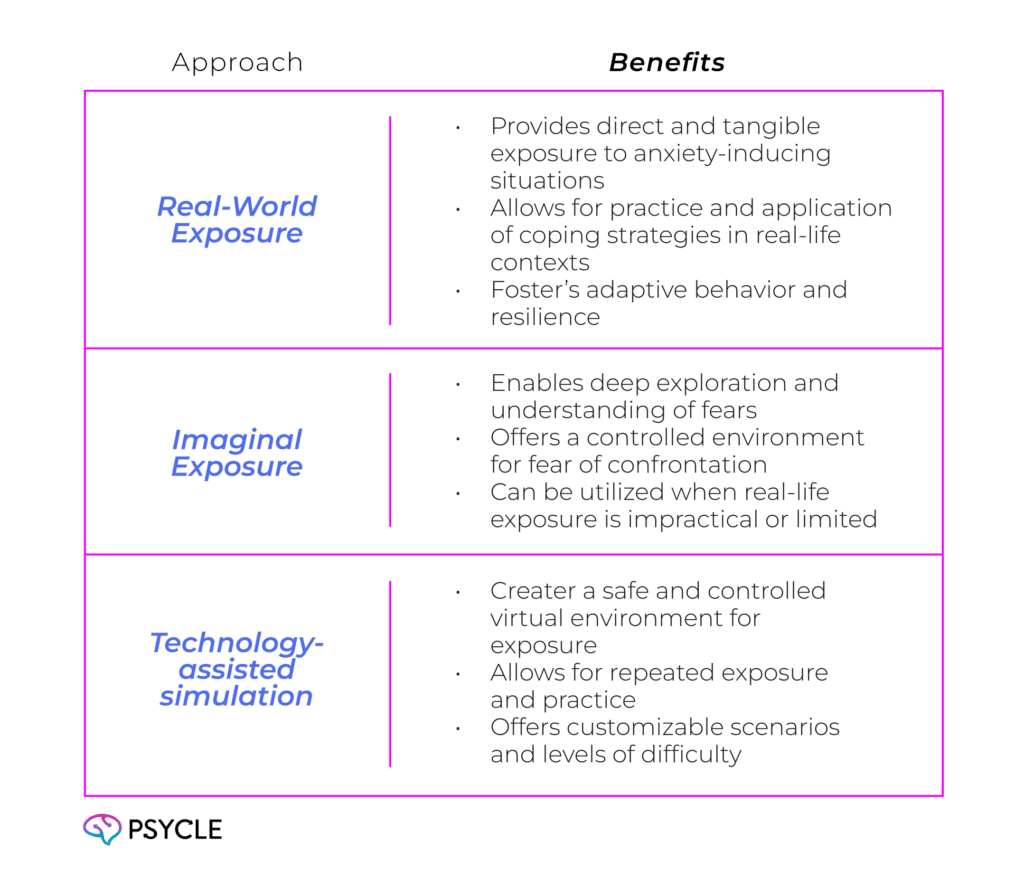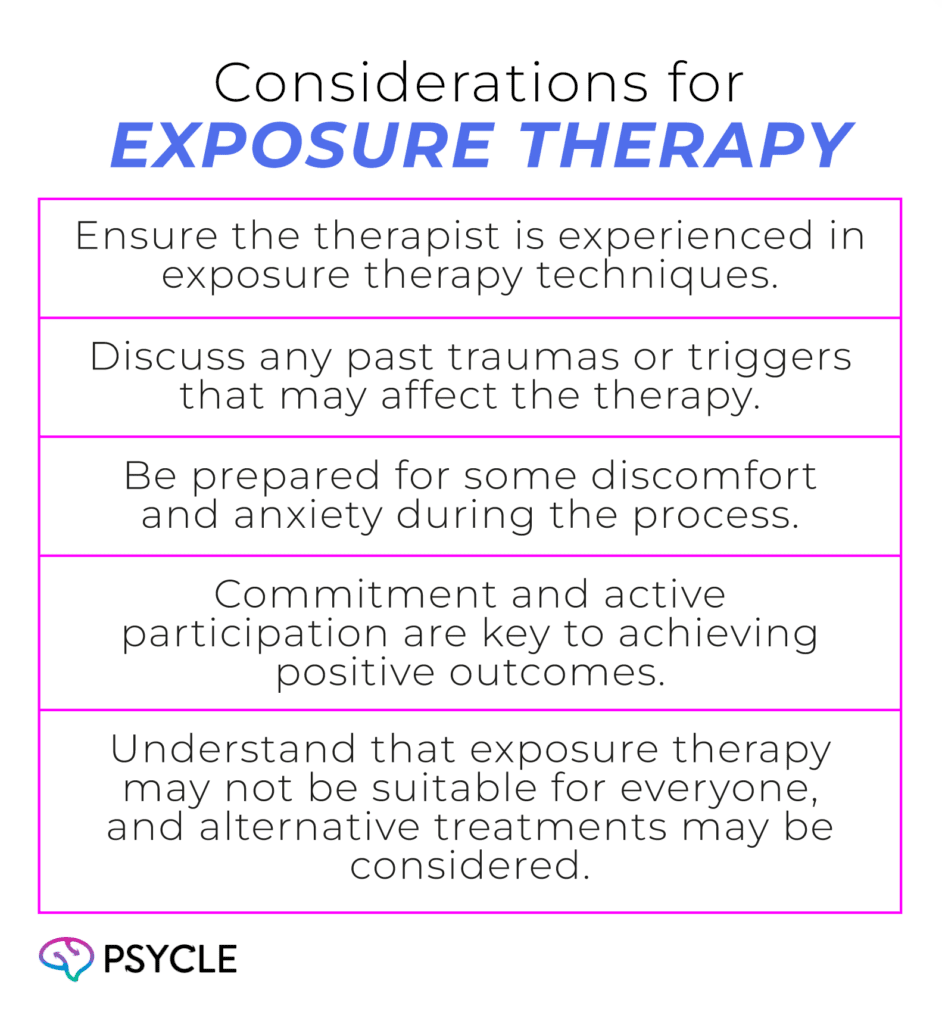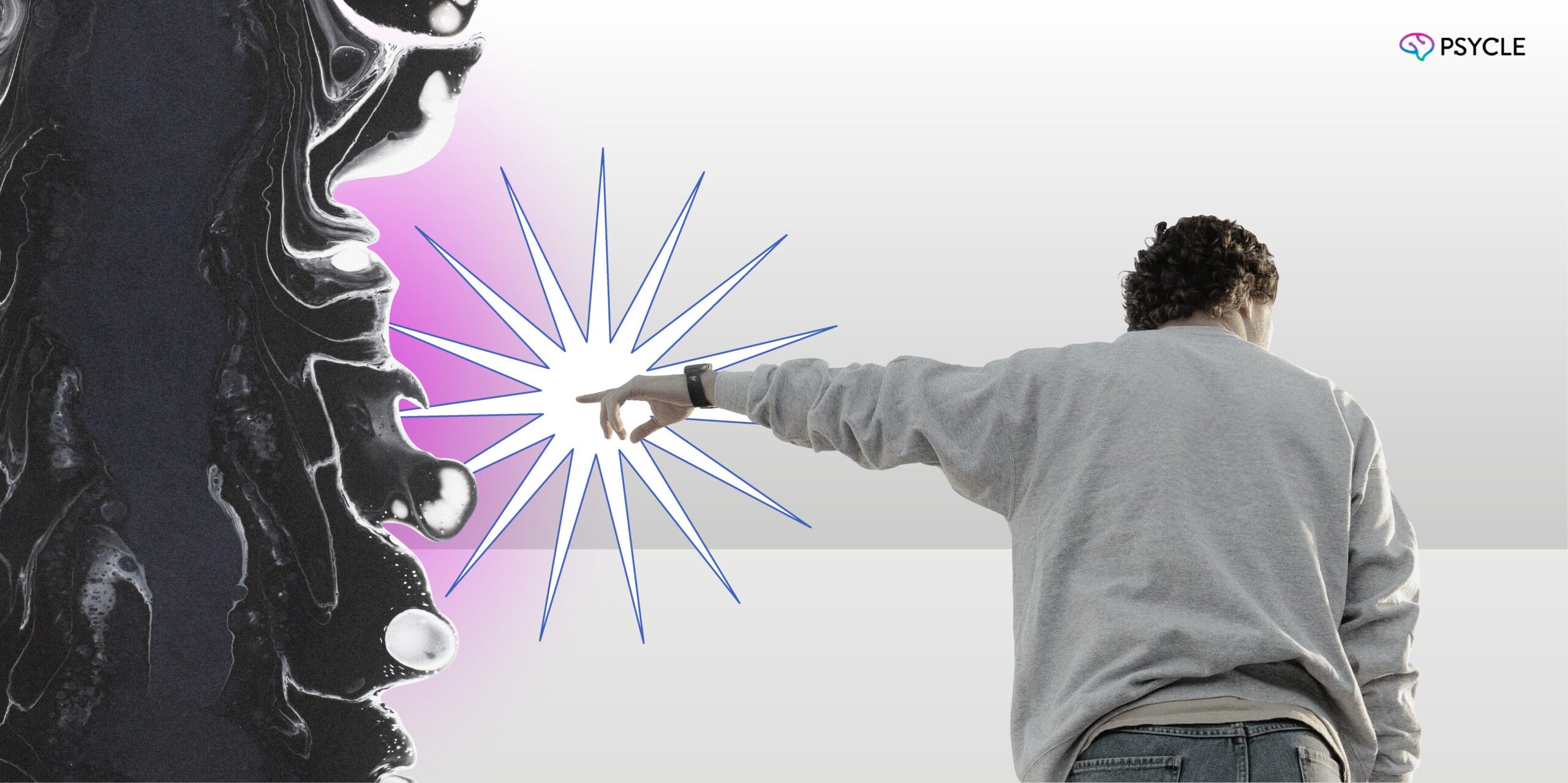Exposure therapy is a cognitive-behavioral technique that aims to reduce fear and anxiety in individuals. It is a proven method used to combat phobias, anxiety disorders, and post-traumatic stress disorder (PTSD) through gradual, guided confrontation. By creating a hierarchy of fears and exposing individuals to these fears in a controlled manner, exposure therapy helps individuals overcome their anxiety and regain control of their lives.
Key Takeaways
- Exposure therapy is a cognitive-behavioral technique to reduce fear and anxiety in individuals.
- It involves gradual, guided confrontation of anxiety-inducing situations.
- Exposure therapy can be applied to various mental health conditions, including PTSD, OCD, social anxiety, phobias, and panic disorder.
- The therapy follows a systematic process involving the creation of a fear hierarchy, gradual exposure, and desensitization.
- Research supports the efficacy of exposure therapy as an effective treatment for anxiety disorders.
Types of Exposure in Therapy
Exposure therapy offers various approaches to help individuals confront their fears and reduce anxiety. These approaches include:
- Real-world exposure: This form of exposure therapy involves direct confrontation of anxiety-inducing situations in real-life settings. It allows individuals to gradually face their fears and build resilience in the actual environments that trigger their anxiety. For example, a person with a fear of heights may gradually expose themselves to heights by climbing progressively higher.
- Imaginal exposure: Imaginal exposure therapy utilizes the power of the mind to confront fears. Individuals visualize and vividly imagine anxiety-provoking scenarios, enabling them to deeply explore their fears within a safe and controlled setting. Through this process, they can desensitize themselves and reduce anxiety. For instance, a person with a fear of public speaking may imagine themselves delivering a successful speech in front of an audience.
- Technology-assisted simulation: Technology has opened up new possibilities in exposure therapy. Virtual reality (VR) and other technology-assisted simulations provide a safe and controlled environment for individuals to confront their fears. With VR, individuals immerse themselves in realistic virtual scenarios that replicate their anxiety-inducing situations. This immersive experience allows for repeated exposure and practice, facilitating desensitization and anxiety reduction.
Each type of exposure therapy offers unique benefits:

By employing these different exposure approaches, therapists can tailor the therapy to the individual needs of their clients, maximizing the effectiveness of exposure therapy.
Applications of Exposure Therapy
Exposure therapy is a versatile technique that has proven to be effective in treating a range of mental health conditions, offering hope to individuals struggling with post-traumatic stress disorder (PTSD), obsessive-compulsive disorder (OCD), social anxiety, phobias, and panic disorder.
For individuals with PTSD, exposure therapy can help them confront and manage the traumatic experiences that have caused distress. By gradually exposing patients to their triggers in a safe and controlled environment, exposure therapy offers the opportunity to reduce anxiety and minimize the impact of traumatic memories.
Those who suffer from OCD can find relief through exposure therapy, as it provides a structured approach to challenge obsessive thoughts and compulsive behaviors. By exposing individuals to situations that trigger their OCD symptoms, exposure therapy enables people to learn how to resist engaging in rituals and confront their fears head-on.
Social anxiety can be debilitating, making it difficult for individuals to engage in social situations. Exposure therapy offers a way to confront and overcome these fears gradually, providing the tools needed to build confidence and reduce anxiety. Through the process of gradually facing anxiety-inducing social situations, individuals can learn to navigate social interactions with greater ease.
Phobias, whether it be a fear of heights, spiders, or flying, can significantly impact a person’s quality of life. Exposure therapy provides a systematic and supportive approach to help individuals face their fears gradually. By exposing them to their phobias in a controlled and supportive environment, exposure therapy helps reduce anxiety and teaches individuals how to manage their specific phobias.
Panic disorder is characterized by recurrent panic attacks and the fear of having future attacks. Exposure therapy can address panic disorder by gradually exposing individuals to the physical sensations associated with panic attacks in a safe environment.
By confronting these sensations in therapy sessions, individuals can become desensitized and learn coping strategies to manage and reduce their panic symptoms.
How Does Exposure Therapy Work?
Exposure therapy is a powerful method for confronting fears and managing anxiety. This therapy involves a combination of in-session exercises, homework assignments, and technology-assisted simulations, providing a comprehensive approach to anxiety reduction.
During exposure therapy, individuals are exposed to their fears in a controlled and supportive environment. They remain in or near the anxiety-inducing situation until their anxiety gradually decreases. This gradual exposure helps individuals become desensitized to their fears and experience a reduction in anxiety over time.
Therapists also teach practical strategies to manage anxiety during exposure therapy. These strategies may include controlled breathing techniques, relaxation exercises, or mindfulness practices. By developing these coping mechanisms, individuals can better manage their anxiety and navigate anxiety-inducing situations with confidence.
The Process of Exposure Therapy
The goal of exposure therapy is to confront and overcome fears Guided by a trained therapist gradually, this therapy involves creating a hierarchy of fears, engaging in gradual exposure, and promoting desensitization.
Creating a Hierarchy of Fears
A key step in exposure therapy is creating a hierarchy of fears. The therapist and individual work together to identify and rank anxiety-inducing situations based on their level of distress. This hierarchy serves as a roadmap to guide the exposure therapy process.
By breaking down fears into manageable steps, individuals can begin with situations that only cause mild anxiety and gradually progress to more challenging ones. This allows them to build confidence and resilience over time.
The Gradual Exposure Process
Once the hierarchy of fears is established, the gradual exposure process begins. It involves intentionally and repeatedly exposing individuals to anxiety-inducing situations, starting with those at the bottom of the hierarchy.
During each exposure session, individuals are encouraged to face their fears head-on while seeking support from the therapist. This gradual approach ensures that individuals feel safe and in control as they confront their anxieties.
Promoting Desensitization
Through repeated exposure to anxiety-provoking situations, exposure therapy aims to promote desensitization. This means that over time, individuals become less sensitive to their fears and anxieties.
As individuals progress through the hierarchy of fears and gradually face more challenging situations, they develop new coping strategies and learn that their fears are often exaggerated or unwarranted. This desensitization process leads to a reduction in anxiety and an increased ability to manage fears effectively.
By following the process of exposure therapy, individuals can build courage, confront their fears, and ultimately reduce anxiety in their lives.
Research on Exposure Therapy
Exposure therapy has garnered substantial support from empirical research, with numerous studies demonstrating its effectiveness in treating various anxiety disorders. Studies show significant improvement in individuals undergoing exposure therapy, confirming its efficacy as an empirically supported treatment option.
One area where exposure therapy has shown promising results is social anxiety disorder. Research has indicated that exposure therapy can effectively reduce social anxiety symptoms and improve individuals’ ability to engage in social situations with greater ease and confidence.
Moreover, exposure therapy has demonstrated positive outcomes in the treatment of obsessive-compulsive disorder (OCD). Studies have shown that exposure and response prevention, a specific form of exposure therapy, can significantly reduce OCD symptoms and improve an individual’s quality of life.
Research has also indicated that exposure therapy is an effective intervention for panic disorder. By systematically confronting feared sensations and situations, individuals can learn to manage their anxiety and reduce the frequency and intensity of panic attacks.
Additionally, exposure therapy has been found to be beneficial for individuals with post-traumatic stress disorder (PTSD). Through repetitive and controlled exposure to trauma-related stimuli, individuals can gradually process and reduce the distress associated with traumatic memories.
Overall, the empirical support for exposure therapy reinforces its efficacy as a core component of cognitive-behavioral therapy for anxiety disorders. The consistent findings from research studies contribute to the growing recognition and acceptance of exposure therapy as a valuable treatment option.
Finding a Therapist for Exposure Therapy
To find a therapist for exposure therapy, you have several options. One approach is to consult with your primary care physician or mental health professional. They can provide recommendations based on their knowledge and experience in the field.
Additionally, they may refer you to specialized clinics or professionals who offer exposure therapy services.
Another option is to utilize online directories that list therapists specializing in exposure therapy. These directories typically provide profiles and reviews of therapists, allowing you to assess their qualifications and suitability for your needs.
When exploring these resources, pay attention to factors such as their level of experience, areas of expertise, and any certifications or accreditations they hold.
When seeking exposure therapy, make sure to find a therapist who specializes in this technique. Working with a qualified exposure therapy specialist can greatly enhance the effectiveness of your treatment.
Look for therapists who have experience and training in cognitive-behavioral therapy (CBT) and exposure therapy. These therapists possess the knowledge and skills necessary to guide you through the process of facing your fears.
Considerations when choosing a therapist for exposure therapy:
- Expertise: Ensure that the therapist has substantial experience and training in exposure therapy, as it requires specific skills to effectively guide individuals through the process.
- Compatibility: The therapeutic relationship is important, so consider whether you feel comfortable and understood by the therapist during your initial consultation or assessment.
- Evidence-based approach: Look for a therapist who follows evidence-based practices and integrates exposure therapy into a comprehensive treatment plan.
- Specialization: Some therapists may specialize in certain areas, such as phobias, PTSD, or social anxiety disorder. Consider your specific needs and whether the therapist has expertise in treating those conditions.
- Availability: Check the therapist’s availability and schedule to ensure it aligns with your own availability for regular sessions.
Remember, finding the right therapist is an essential step in your journey toward overcoming fears and anxiety. Take the time to research and select a therapist who is experienced in exposure therapy and suits your individual needs.
With the guidance and support of a qualified therapist, you can maximize the benefits of exposure therapy and work towards lasting change.
Duration of Exposure Therapy
The length of exposure therapy can vary from person to person, depending on a few factors. These factors include the severity of the fear or anxiety being addressed, the complexity of the mental health condition being treated, and the individual’s commitment to the therapy process.
For some individuals, significant improvement may be seen in just a few sessions of exposure therapy. This can occur when the fear or anxiety being addressed is less severe or when the individual has a strong commitment to the therapy process.
On the other hand, some individuals may require several sessions spread out over a longer period of time. This is especially true for individuals with more severe fears or anxieties and those with complex mental health conditions.
It’s important to remember that exposure therapy is a gradual process that takes time and commitment. Progress can vary from session to session, and each individual’s journey is unique. The focus should be on making steady progress and building resilience rather than strictly adhering to a specific timeline.
Throughout the course of therapy, the individual and therapist work together to assess progress and adjust the treatment plan as needed. This collaborative approach ensures that exposuretherapy remains tailored to the individual’s specific needs and helps to optimize its benefits.
Benefits and Considerations of Exposure Therapy
Exposure therapy offers numerous benefits for individuals struggling with fears, phobias, and anxiety disorders. It is designed to address avoidance behaviors and provide long-lasting results. By gradually exposing individuals to anxiety-inducing situations, exposure therapy helps them confront their fears in a safe and controlled environment.
One of the key benefits of exposure therapy is its ability to address avoidance behaviors. Many individuals with anxiety disorders or phobias tend to avoid situations or triggers that cause them distress. Exposure therapy targets these avoidance behaviors by gradually exposing individuals to their fears, helping them build resilience and overcome their anxiety.
Moreover, exposure therapy can lead to long-lasting results. The gradual exposure to anxiety-inducing situations helps individuals become desensitized to their fears over time, reducing the impact of anxiety on their daily life.
By actively confronting their fears, individuals can develop healthier coping mechanisms and experience a lasting reduction in anxiety levels.
However, it is crucial to work with a trained therapist when undergoing exposure therapy. A qualified therapist will guide individuals through the process, ensuring their safety and well-being throughout the treatment. Prior to starting exposure therapy, it is essential to have open and honest discussions with the therapist about any concerns or potential risks involved.

Conclusion
Exposure therapy is a proven and effective technique for reducing fear and anxiety in individuals with phobias, anxiety disorders, and post-traumatic stress disorder (PTSD). By gradually exposing individuals to anxiety-inducing situations, exposure therapy allows them to confront their fears and build resilience over time. Research consistently supports the use of exposure therapy as an essential component of cognitive behavioral therapy.
If you are considering exposure therapy, it is important to seek a therapist who specializes in this technique. They will have the expertise and experience to guide you through the process and maximize the potential benefits. During therapy, you will work collaboratively with your therapist to create a personalized treatment plan that addresses your specific needs and goals.
Remember, managing fears and anxieties is a journey that takes time and commitment. However, the outcomes can be life-changing. With exposure therapy, you have the opportunity to regain control over your life and reduce the impact of fear and anxiety.
Take the first step towards a brighter future by exploring exposure therapy as an option for managing your mental health.
FAQs
How Long Does Exposure Therapy Typically Last?
The length of exposure therapy varies depending on factors such as the severity of the fear or anxiety, the complexity of the mental health condition, and the individual’s commitment to the therapy. Some individuals may see improvement in just a few sessions, while others may require several sessions spread over a longer period of time.
What are the Benefits and Considerations of Exposure Therapy?
Exposure therapy has several benefits, including addressing avoidance behaviors and reducing the impact of fears and anxiety on daily life. It can lead to long-lasting results and help individuals regain control over their lives. However, it is important to work with a trained therapist and discuss any concerns or risks before starting exposure therapy.
How Can I Find a Therapist for Exposure Therapy?
When seeking exposure therapy, it is important to find a therapist who specializes in this technique. You can consult with your primary care physician or mental health professional for recommendations or search online directories for therapists who offer exposure therapy.

